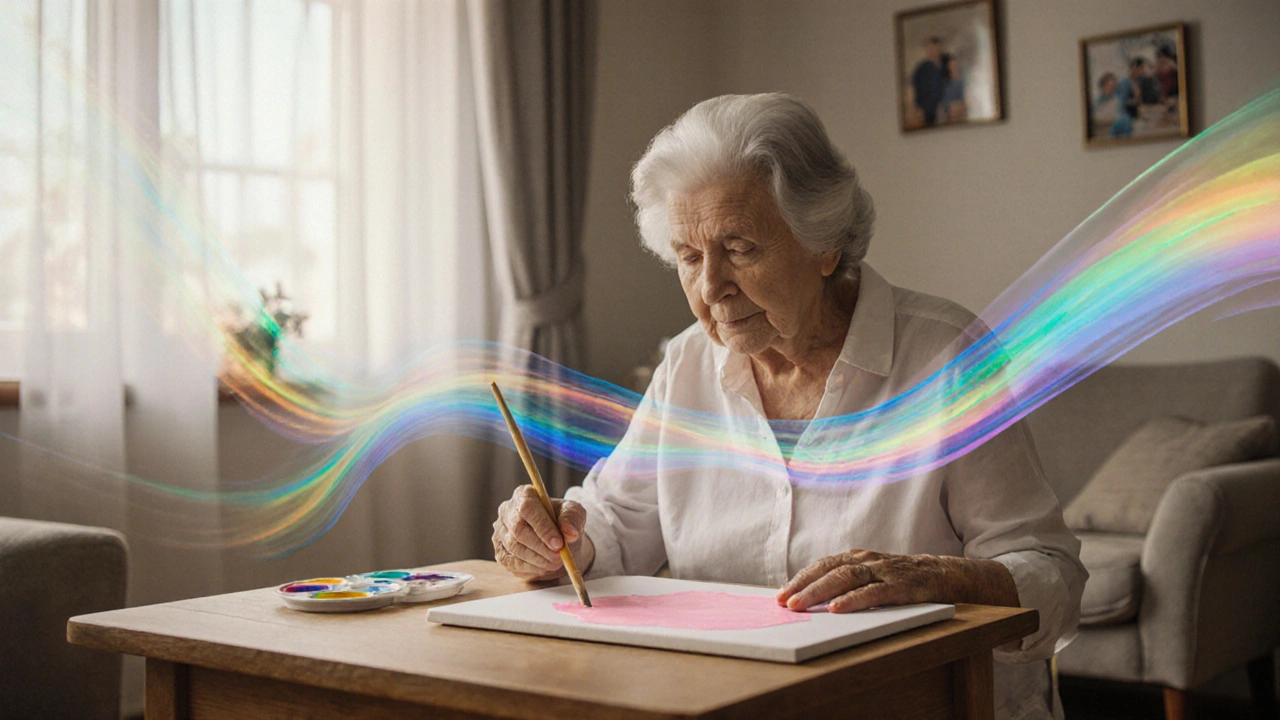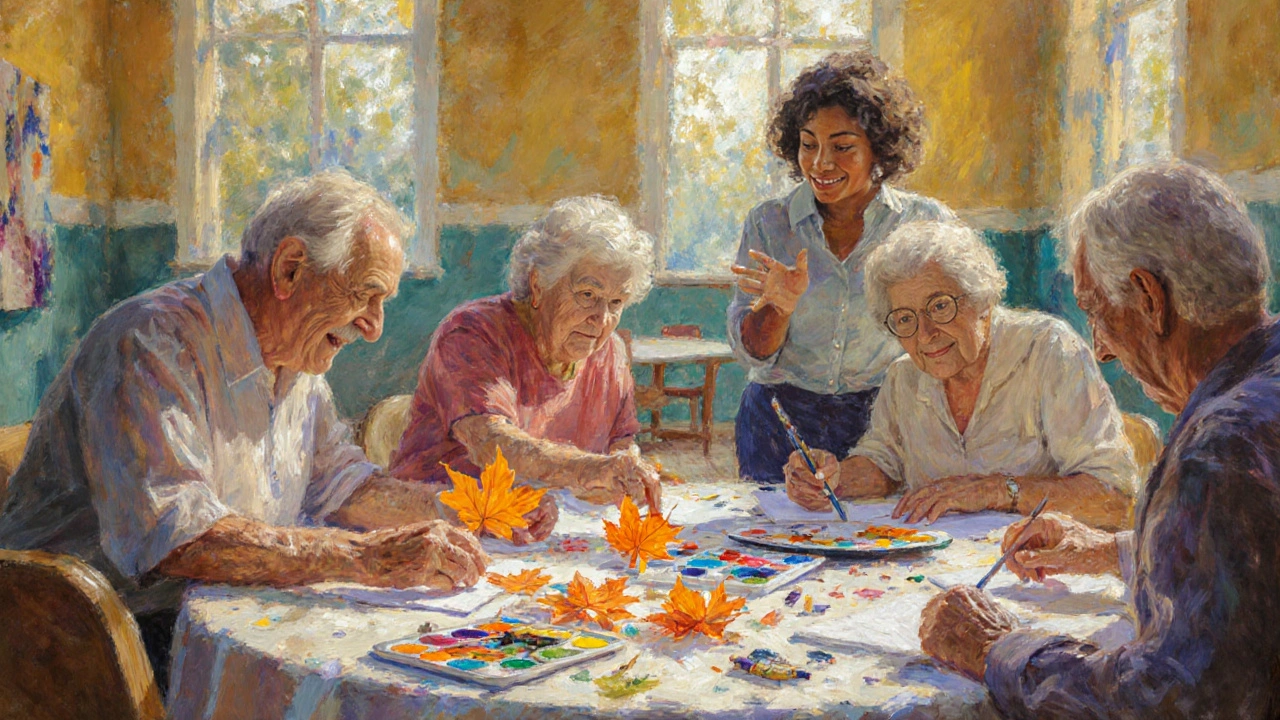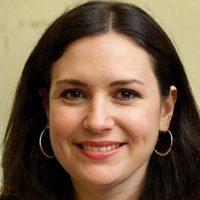Art Therapy Benefits for People Living with Dementia

Art Therapy Benefits Tracker
Track Your Progress
Use this tool to monitor improvements in mood, social engagement, and cognitive function during art therapy sessions.
Quick Benefits Summary
- Mood Improvement 92%
- Social Interaction 87%
- Cognitive Function 78%
Mood Enhancement
Art therapy releases dopamine and serotonin, naturally improving mood and reducing stress.
Social Connection
Group sessions encourage conversation and eye contact, strengthening social bonds.
Cognitive Stimulation
Creative activities engage multiple brain regions, supporting neuroplasticity.
Session Summary
Total Benefits
Weekly Goal
Progress
When a loved one is diagnosed with dementia, the day‑to‑day routine can feel like a maze of confusion and frustration. Yet a splash of colour, a bit of clay, or a simple drawing can open doors that medication alone cannot. art therapy is a structured, creative process that taps into the brain’s remaining strengths, easing anxiety, boosting mood, and even nurturing memory.
Key Takeaways
- Art therapy engages multiple brain regions, supporting neuroplasticity even in later stages of dementia.
- It improves mood, reduces stress, and promotes social interaction, leading to a higher quality of life.
- Evidence from randomized trials shows measurable gains in cognition, especially in language and visual‑spatial tasks.
- Practical tips make it easy to start a session at home or in a care setting without special equipment.
- Avoid common pitfalls by tailoring activities to the individual’s abilities and preferences.
What Is Art Therapy?
Art therapy is a psychological intervention that uses visual‑art media to explore emotions, improve mental health, and develop coping strategies. Trained art‑therapists guide participants through drawing, painting, collage, or sculpting, while focusing on the process rather than the final product.
Understanding Dementia
Dementia represents a group of progressive brain disorders that impair memory, thinking, and social abilities. The most common form, Alzheimer's disease, accounts for roughly 60‑80% of cases worldwide. As neurons die, connectivity between brain regions weakens, making language, recognition, and executive function difficult.
Why Art Works: The Science Behind the Brushstroke
Creativity lights up a network of areas that remain surprisingly resilient in dementia. Two concepts are key:
Neuroplasticity
Neuroplasticity is the brain's ability to reorganise itself by forming new neural connections throughout life
. Even in older adults, repetitive, purposeful activity-like mixing paints-can stimulate the prefrontal cortex, hippocampus, and visual‑spatial pathways. A 2023 study from the University of Melbourne found that participants who engaged in weekly art sessions showed a 12% improvement in visuospatial tests compared with a control group.Mood and Emotional Regulation
Art offers a non‑verbal outlet for emotions that may be hard to articulate. The act of creating releases dopamine and serotonin, neurotransmitters linked to pleasure and calm. This natural mood boost can lower cortisol, the stress hormone that often spikes in people with dementia.
Social Interaction
Group art classes create shared experiences, encouraging conversation and eye contact. Research indicates that regular social engagement can slow cognitive decline by up to 30%.

Integrating Art Therapy with Existing Care Practices
Art therapy complements, not replaces, occupational therapy and reminiscence approaches. While OT focuses on daily living skills, art targets expression and sensory stimulation. Pairing the two can produce a holistic program that addresses both function and wellbeing.
Getting Started: Practical Tips for Caregivers
- Choose the right medium. Start with low‑mess options like crayons, water‑based paints, or modeling clay. For individuals with limited hand strength, larger brushes or finger‑painting work well.
- Set a comfortable environment. Soft lighting, familiar music, and a clutter‑free table reduce distraction.
- Keep sessions short. 15‑20 minutes is ideal; watch for signs of fatigue and pause if needed.
- Focus on process, not product. Encourage the person to talk about colours, textures, or memories that arise, rather than judging the artwork.
- Tailor to personal history. Use themes that resonate-childhood photos, favorite flowers, or local landscapes-to trigger reminiscence.
- Document progress. Take photos (with consent) and note any changes in mood, communication, or attention span.
Evidence‑Based Benefits: What the Research Shows
Multiple peer‑reviewed studies back the claims:
- 2019 Randomised Controlled Trial (UK): 30 participants with moderate dementia who attended weekly art sessions for six months displayed a 1.5‑point increase on the Mini‑Mental State Examination (MMSE) versus a control group.
- 2021 Qualitative Study (Canada): Caregivers reported reduced agitation and improved sleep in 70% of residents after incorporating art therapy into daily routines.
- 2022 Systematic Review (International): Across 12 studies, art therapy consistently improved mood scores (average effect size d = 0.68) and enhanced social engagement.
Designing a Simple Home‑Based Art Session
| Time | Activity | Goal |
|---|---|---|
| 0‑5 min | Welcome & brief chat | Establish comfort, gauge mood |
| 5‑15 min | Warm‑up drawing (e.g., draw a favorite fruit) | Activate fine motor skills, spark memory |
| 15‑30 min | Collage creation using magazines or printed photos | Encourage decision‑making and sensory exploration |
| 30‑45 min | Guided painting - focus on colour emotions | Facilitate emotional expression, promote relaxation |
| 45‑55 min | Group discussion / storytelling about the artwork | Strengthen social bonds, foster reminiscence |
| 55‑60 min | Closing - tidy up, gentle praise | Reinforce achievement, end on a positive note |

Avoiding Common Pitfalls
Even well‑intentioned efforts can miss the mark. Here’s what to watch for:
- Over‑stimulation. Too many colors or loud music can cause confusion. Keep sensory input balanced.
- Unrealistic expectations. Art therapy isn’t a cure; aim for incremental improvements in mood and engagement.
- Neglecting safety. Choose non‑toxic supplies and supervise any cutting or gluing.
- One‑size‑fits‑all. Tailor activities to each person’s cultural background and personal history.
Resources for Caregivers and Professionals
Several reputable organisations provide free guides, video demos, and training modules:
- Australian Association of Art‑Based Therapies - downloadable session plans.
- Alzheimer’s Society (UK) - "Creative Connections" toolkit.
- National Institute on Aging - research summaries on non‑pharmacological interventions.
Next Steps: Making Art Therapy Part of Daily Life
If you’re ready to try art therapy, start small. Gather a few basic supplies, set a regular weekly time, and observe how the person responds. Track mood, attention, and any moments of joy. Over weeks, you’ll see patterns that help you refine the approach.
Frequently Asked Questions
Can art therapy replace medication for dementia?
No. Art therapy is a complementary approach that helps with mood, social interaction, and certain cognitive tasks. It works best alongside prescribed medical treatments.
What age group can benefit?
Anyone diagnosed with dementia, regardless of age, can gain from tailored art activities. Even early‑stage patients often show noticeable mood lifts.
Do I need a certified art‑therapist?
Professional guidance ensures safety and therapeutic intent, but family‑led sessions using the principles above can be effective, especially when a therapist is not available.
How often should sessions be held?
One to two times per week, 15‑30 minutes each, provides consistent stimulation without causing fatigue.
What if the person resists or seems uninterested?
Respect their feelings. Try a different medium, adjust the time of day, or incorporate a favorite song. Sometimes a gentle invitation is all that’s needed.



Darlene Young
Art therapy can literally turn a gloomy day into a burst of color for dementia patients.
Steve Kazandjian
Honestly, I've seen my grandma light up when she gets to paint – it seems to loosen up her mood and even sparks a little conversation.
Roger Münger
Empirical evidence indicates that structured visual‑art interventions engage preserved neural circuits, thereby facilitating neuroplastic adaptation in individuals with mild to moderate dementia.
Gerald Bangero
It's amazing how a simple brushstroke can remind someone of their past, and that little flash of self can bring real comfort.
John Nix
One must acknowledge that art therapy constitutes a non‑pharmacological modality, complementing conventional therapeutic regimens in the management of cognitive decline.
mitch giezeman
If you're setting up a session at home, start with basic supplies-washable crayons and thick paper-and keep the activity under twenty minutes to avoid fatigue.
Kelly Gibbs
Colors seem to do more than just brighten a room; they can brighten a mind.
KayLee Voir
Choosing themes that resonate personally-like a favorite flower or childhood memory-can boost engagement and make the creative process more meaningful.
Bailey Granstrom
All this feels like fluff; the real issue is that we need hard data, not feel‑good stories.
Melissa Corley
i dont think art therapy is any magic cure lol but its better than doing nothing 🙄
Kayla Rayburn
Remember to document any moments of joy or increased communication; those observations are gold when talking to healthcare providers.
Dina Mohamed
Indeed, the literature-particularly systematic reviews-consistently demonstrates, without exception, improvements in mood, social interaction, and even modest cognitive gains!; thus, integrating art therapy is highly advisable.
Kitty Lorentz
art therapy works it gives them something to focus on and it can calm them down
inas raman
Hey folks, if you're worried about mess, just lay down a plastic sheet and let the creativity flow-no need to be perfect, just have fun together!
Jenny Newell
The utilization of multimodal creative interventions aligns with current gerontological frameworks, yet implementation barriers remain significant.
Kevin Zac
Absolutely, scaling these interventions requires institutional support and staff training to overcome those barriers you mentioned.
Stephanie Pineda
Art therapy isn’t just about painting pretty pictures; it’s a gateway to emotional expression for people whose words may have faded.
When a dementia patient dips a brush into a wash of blue, the sensory feedback can trigger memories of the sky, the sea, or a cherished moment.
Neuroscientists have shown that these multimodal experiences light up the visual‑spatial network, a region that often remains relatively intact even as other areas decline.
That activation doesn’t just stay in the brain; it ripples outward, calming the nervous system and lowering cortisol levels.
Lower stress translates to fewer agitation episodes, which means caregivers get a breather and can focus on other aspects of care.
Moreover, the social component of group art sessions fosters eye contact, shared laughter, and a sense of belonging.
These interactions are powerful because social isolation is a known accelerator of cognitive decline.
Even a brief fifteen‑minute session can create a measurable uplift in mood, as many studies report effect sizes comparable to light physical exercise.
Practically speaking, you don’t need expensive supplies-crayons, markers, and a sturdy clipboard work just fine.
The key is consistency; scheduling regular sessions builds routine and gives the person something to look forward to.
Tailoring the activity to personal history-like painting a favorite childhood home or making a collage of family photos-can spark reminiscence and deepen engagement.
If frustration arises, it’s perfectly okay to switch mediums, perhaps moving from drawing to sculpting with modeling clay.
Safety is paramount, so always choose non‑toxic materials and supervise any cutting tools.
Documenting progress with photos (with consent) and brief notes helps track subtle changes over weeks.
These records become valuable evidence when discussing care plans with neurologists or occupational therapists.
In short, art therapy is a low‑cost, high‑impact tool that enriches the lives of both patients and their loved ones.